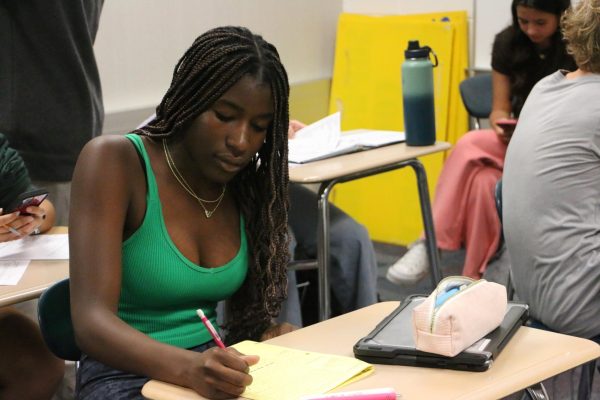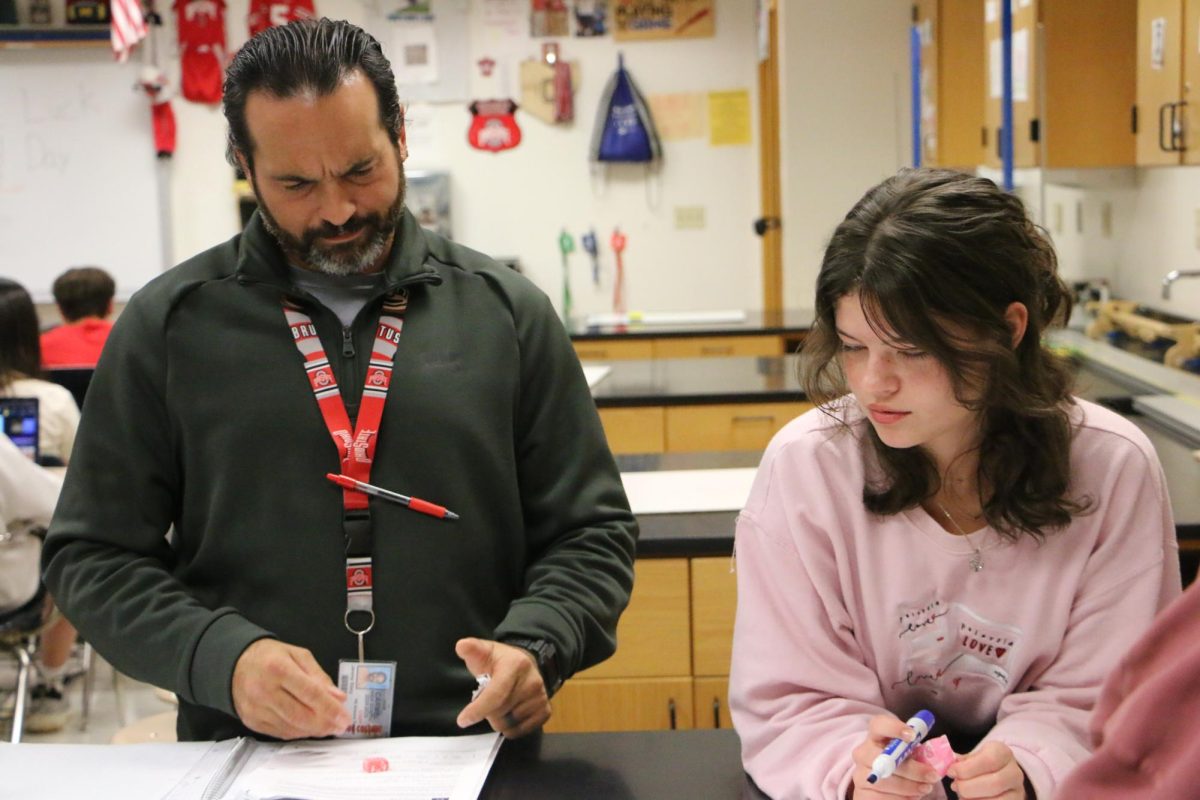Everyday Impact
Will Spence, DECA president and senior, said he started using social media much more after entering high school as he found it became more intertwined in his everyday activities. He said it expanded his capacity to interact with the world, but he said it also tended to isolate him from it as well.
“I can see what’s going on, I can see what activities I want to attend,” he said. “I can see what my family and friends are up to. Downsides? Obviously it takes up a lot of my time. We don’t need to talk about my screen time; it’s absolutely horrendous. It distracts me from potentially spending more time socializing with my family and friends as well because I will be on my phone instead.”
Knowledge about the negative effects of social media have been established for years. But recently, renewed concern has been mounting. On June 17, 2024, Dr. Vivek Murthy, the U.S. Surgeon General, called for a warning label on all social media applications. He cited its negative effects, especially on teens.

“Adolescents who spend more than three hours a day on social media face double the risk of anxiety and depression symptoms, and the average daily use in this age group, as of the summer of 2023, was 4.8 hours,” Murthy wrote. “Additionally, nearly half of adolescents say social media makes them feel worse about their bodies.”
Spence said while he did not directly feel anxiety and depression from his social media use, he admitted that it did shape his tastes and expectations for himself.
“For me personally, I wouldn’t say I am affected by unrealistic expectations because I try to avoid those posts. I’m not interested,” he said.
Despite social media’s ostensibly harmless effects on his lifestyle, Spence also said he recognized the more indirect avenues through which social media has affected his well-being and the well-being of those around him, suggesting that social media’s effect on individuals’ health can be much more pervasive than they think.
Head of counseling Rachel Cole said, “I think a lot of people fall into the unrealistic expectations set by social media. It all comes down to how they react and how confident you are with yourself and if you have a healthy support system.”
Self Image
Spence recalled one of the most apparent ways social media affected his friends was by pushing content that exacerbated body image issues, ultimately hindering their progress toward meaningful fitness transformations.
“What I’ve seen a lot of is that some of my friends who haven’t been working out for long will see more lifting content on their social media because the algorithm shows them what they’re interested in,” Spence said. “So they’ll start seeing individuals who’ve been working out for the longest time and it can affect them because they’ll feel like they’re not good enough or that they’re not working hard enough. They forget that it’s a process and they feel like they should have results. Sometimes it makes them give up because they don’t feel like they’re getting anywhere.”
AP Physics teacher Jeremy Stacy said social media’s endless feed of unrealistic content not only dictated body image standards, but also favorable personality traits. He said that he noticed visible distress as students attempted—and failed—to alter certain aspects of their identity in order to conform.
“I’ve known several kids, one of my best friends’ daughter struggles with it, the peer pressure that comes from social media,” he said. “Whatever she sees on social media, she thinks that’s necessarily real life. She thinks she has to be that size or look that way or act that way, and it has definitely hurt her and other kids negatively from a social and emotional standpoint. I think it causes them to put unrealistic expectations on themselves.”
Cole said social media just gives students another way to access more information and situations that might lead to amplified body issues and dysmorphia.
Fashion
In addition to self-image, according to an article from the Indian Institute of Art and Design, social media has allowed fashion to connect with more people, which can also lead to societal pressure. With a large part of social media users being high school students, these tendencies in style have made their way to younger audiences.
Stacy said he has seen how the media shapes people’s perception on ideas such as fashion.
“Before social media, It was billboards, it was magazines, it was commercials,” Stacy said. “They put out unrealistic expectations of what societal norms should be. They determine what fashion and clothes to wear.”
Senator and sophomore Kayla Aba said she has found social media influences her fashion choices. For example, when Aba is online and she sees an outfit she likes, she said she feels inclined to buy it.
“I’m making my own style, just from different pieces and parts online,” Aba said.
Another article stated that peers have a large influence on what teenagers choose to wear to school. Their outfits reflect what their social circles or other popular kids around school are wearing. While clothing and accessories allow students to express their individuality and identity, it is quite common for students to conform to the fashion that is popular.
Aba said she thinks twice when she wears something might not be trending to school. She said that social media has morphed the stylistic choices of the students around her. They lean toward the trends and micro-trends that fast fashion has been putting out.
Cole added that her favorite social media pastime is to shop. She said social media influences her to make lots of purchases.
“Sometimes you want to wear something, like in high school, but you don’t want to feel like an outcast,” Aba said. “Sometimes you want to wear something but like, ‘Oh, it’s not in style,’ or ‘It’s not what people like,’ so I shouldn’t wear it.”
Spence said social media is a big factor that shapes the way he dresses. “When I look back five years ago, I wasn’t on social media nearly as much. My outfits reflect that,” Spence said. “Social media has had a positive effect on my fashion taste.”
Academic Performance
Both Spence and Aba also said they felt pressure academically due to their use of social media platforms. They both mentioned videos they’ve seen online that made them feel as if they need to be doing more in school and in extracurriculars.
“I wouldn’t say [videos] are something that discourages me, but they make me feel like I’m never going to be good enough,” Spence said. “I think it could definitely cause some people to want to give up.”

Aba said when she is scrolling on social media, she has “blinders” on. When she is watching a video about someone’s college acceptances or academic statistics, she said she doesn’t think to look at the full picture, comparing herself and thinking about how much she has to improve.
“You don’t know, like CHS is such a big school. There’s like 5,000 people here. Everyone’s in different things, but when you look at those videos, maybe their school only has 200 people, so it’s easier for them, or maybe the people around them aren’t as academically motivated,” Aba said. “When you’re on social media, you don’t get those outside facts; you just get the here and now.”
A study conducted by Semantic Scholar showed the majority of students who use social media feel the need to conform to ideas about social norms and academic performance. For many students, this pressure pushes them to feel levels of stress and anxiety. This in turn can cause a decline in motivation, focus and overall student success.
Spence said he feels so much pressure to overachieve, and since he’s now a senior, he said he has noticed how high the standard is for students to perform.
“The expectation is placed by society as a whole when something is a better fit for someone,” Spence said. “Individuals feel like they are defined by their grades and their extracurriculars and by what they’ve accomplished.”
He said he has found that social media as well as society has made students feel as if they are defined by materialistic aspects of themselves.
“They don’t look at the whole picture like character, personality or kindness,” Spence said, “Giving effort is what matters, and I don’t think that’s considered as much as what’s been accomplished.”


